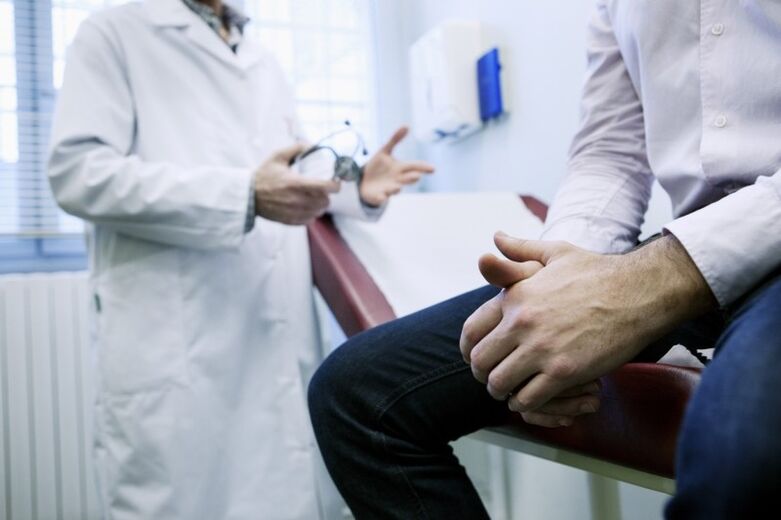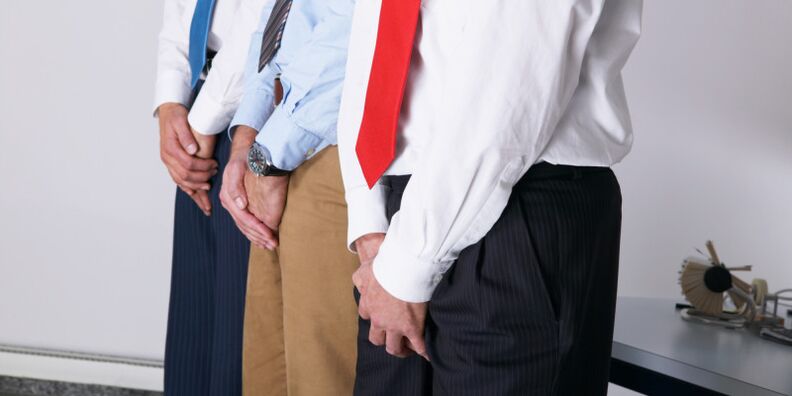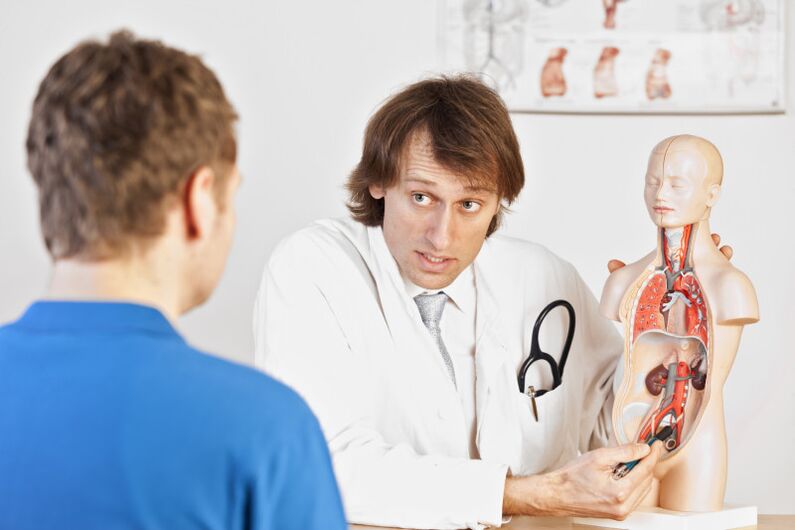
Prostatitis is a formidable disease of the male genital area, which often affects young men under the age of forty. Although the symptoms - decreased sexual desire, difficulty urinating, pain in the groin area - were very painful, the man was in no hurry to seek medical help.
And the reason for this is the insufficient amount of information about the disease, there are too many myths and prejudices about it.
However, the manifestations of prostatitis only worsen over time, therefore, at the first signs of prostatitis, it is necessary to immediately contact a qualified urologist.
Causes of prostatitis
Prostatitis is an inflammation of the prostate gland. Doctors classify the acute and chronic stages of the disease. If the former is not treated, then the inflammation quickly becomes chronic and fraught with many complications, such as sexual dysfunction and even the development of malignant tumors of the prostate.
What are the reasons for its occurrence?
Here are some of them:
- Venereal disease. Often men are carriers of a particular infection, unknowingly, because the disease is completely asymptomatic. However, this picture is very confusing. Once the immune system fails, for example, under the influence of a stressful situation, this gives impetus to the development of prostatitis. The most common causative agents of the disease are herpes viruses, fungi of the genus Candida, Escherichia coli, and so on.
- Untreated bladder infections. In this case, the infection easily spreads to the nearby prostate gland.
- Blood stasis in the pelvic area. This can lead to an inactive lifestyle, an irregular sex life. In this case, there is so -called non -bacterial prostatitis.
- Frequent hypothermia, stress, the presence of infectious foci, including dental caries, in the body.
- Prostatitis can develop as a complication after a severe infectious disease - influenza, tonsillitis and others.
The main symptoms of prostatitis
The most common symptoms of the disease, regardless of the cause, include:
- potential decline;
- pain and difficulty urinating;
- pain of varying severity in the groin and genital area.
Symptoms of acute bacterial prostatitis
As noted above, the first stage of bacterial prostatitis is acute, lasting no more than 3-5 days, after which it slowly turns into chronic.
It is very important not to miss the first symptoms of the disease:
- Pain in groin and scrotum;
- Sharp pain during urination;
- Drawing pain after intercourse in the glans of the penis;
- Erectile dysfunction, reduced duration of sexual intercourse.

A few days after the first symptoms appear, the pain subsides, the man gets the deceptive impression that the threat has passed. However, this only means that prostatitis is slowly but surely becoming chronic.
The course of such diseases is characterized by:
- Alternating periods of remission and exacerbation of prostatitis;
- Difficulty urinating, frequent urination, feeling of incomplete emptying of the bladder accompany the above symptoms of the disease.
During the period of exacerbation of chronic bacterial prostatitis, patients experience the same symptoms as in the acute form.
Even seemingly harmless factors can trigger it:
- hypothermia;
- Cold;
- Erections without consciousness;
- Avitaminosis;
- Stress and overwork;
- Sedentary lifestyle;
- constipation;
- Irregular sexual life;
- Smoking and alcohol abuse.
Symptoms of non -bacterial prostatitis
This disease is also called congestive prostatitis. This is the most dangerous and common type of pathology. Its development is directly related to the way of life of modern man.
Medical researchers compare chronic congestive prostatitis in terms of severity and prevalence with dangerous diseases such as tuberculosis or cancer, because its neglected form is a direct route to prostate cancer.
This form of the disease can be discussed when inflammation of the prostate is not caused by any microorganisms, but by other factors - the absence of prolonged sexual intercourse, inactive lifestyle, frequent stressful situations.
Such conclusions can be drawn from the results of bacteriological studies, which indicate the absence of pathogenic microorganisms.
The symptoms of this form of the disease are quite different from those of bacteria:
- Patients complain of periodic or persistent dull pain in the pelvis, lower abdomen, groin and genitals;
- Sexual dysfunction and problems with urination;
- The mental state of the depressed patient
Symptoms of prostatitis without chronic symptoms

This is a latent form of the disease. As the name suggests, it is asymptomatic, that is, there is an inflammatory process in the prostate, but this does not affect the patient's condition.
Some researchers from the medical field tend to regard this form of pathology only as normal age -related changes in the prostate gland, which occur as a result of disruption of blood supply to organs.
The disease is often detected in patients inadvertently, for example, during abdominal surgery associated with a completely different diagnosis.
To prevent prostatitis, you need to know the cause.
So, the main steps to prevent inflammation of the prostate gland:
- Although the main measures for the prevention of prostatitis, as has been mentioned many times, include frequent sexual activity, it is still worthwhile to avoid casual sexual intercourse or it is important to use barrier contraceptives. This measure is mandatory, as about 30% of cases of prostate inflammation are associated with venereal disease.Alternative Sex- Masturbation is also welcomed by urologists, because no less than sexual intercourse completely increases the blood supply to the prostate gland.
- Physical activity, active lifestyle. Physical education and sports are useful as general strengthening measures, but it is worth focusing on exercises that improve blood circulation in the pelvic area. This includes running, skating, skiing, etc.
- Regular preventive checkups by a urologist or andrologist, at least once a year.
- Timely treatment focuses on infections in the body, for example, sanitation of the oral cavity.
The diagnosis of prostatitis is complex and varied

The diagnosis of prostatitis is associated primarily with identifying the cause of the disease, it includes the following measures:
- Very important to clarify the picture of the disease is a survey of the patient, which must describe in detail his complaints - the localization of specific sensations, their duration, what events are associated with the manifestation, after which it begins. Also, at the appointment, the doctor carefully checks the patient’s medical records for diseases, tests and examinations previously transferred. Urologists explain the patient's information about sexual life, the presence of venereal diseases.
- Examination of smears and abrasions of the urethra. An increase in the number of leukocytes in the smear and the presence of pathological microflora in the abrasion will tell about the presence of infection.
- General urine analysis. Helping to identify the presence of infection, its presence is indicated by an increase in the number of leukocytes (more than 5).
- Ejaculation analysis. Performed to confirm the diagnosis of non -bacterial prostatitis.
- Ultrasound of the prostate. Allows you to see the picture of the disease in the most complete way. It is carried out to clarify the diagnosis in both acute and chronic inflammation of the prostate, suspected of cancer.
Pain and decreased potency - as the first sign of prostatitis
Often, doctors have to deal with an already advanced form of the disease, as most men either tend to ignore the first alarming bell - pain in the groin and decreased libido, or the disease itself is asymptomatic for some time.
These are anatomical features of men - in the prostate area, blood circulation is difficult, it is a "nutrient medium" for the reproduction of pathogenic microorganisms, an inactive lifestyle significantly exacerbates this problem. Thus, the reason for the massive spread of prostatitis among truck drivers and office workers becomes clear.
One way or another, up to 50% of the entire male population in the world has ever experienced certain symptoms of prostatitis. Therefore, it is very important to know the early signs of the disease and seek timely medical help. After all, the treatment of advanced forms of the disease is an expensive and lengthy endeavor.
A treatment that returns the patient to a full life

Of course, it is easier to get rid of prostatitis at an early stage than a neglected disease. However, it is by far the most common chronic form encountered by physicians, and usually requires long -term and complex treatment.
But in any case, you first need to identify the main cause of the pathology - blood stasis and (or) inflammation in the prostate.
So, the complex treatment of prostatitis includes:
- The inflammatory process is treated with broad -spectrum antibiotics. Moreover, the drugs are prescribed in tablet form and in the form of rectal suppositories. In the complex, infusions of medicinal herbs (chamomile, calendula), given in the form of microclysters, help well.
- However, the treatment of prostatitis should not be limited to taking medications, it should aim to restore blood circulation in the prostate area, and this involves a set of physiotherapy and therapeutic exercises. Such measures contribute to better absorption of antibacterial drugs, as they increase the blood supply to the prostate gland. Doctors often prescribe for prostatitis: electrophoresis, laser therapy, magnetotherapy;
- Prostate sequence. This procedure is useful and effective, but it should not be carried out at home, without consulting a doctor, because it has many contraindications, including the acute phase of the disease.
Summing up, we can say that the issue of treatment and prevention of prostatitis largely depends on the desires and activities of the man himself. Basic morning exercises, regular preventive checkups by a urologist, a balanced diet - these are the keys to a man’s strength and longevity!



























